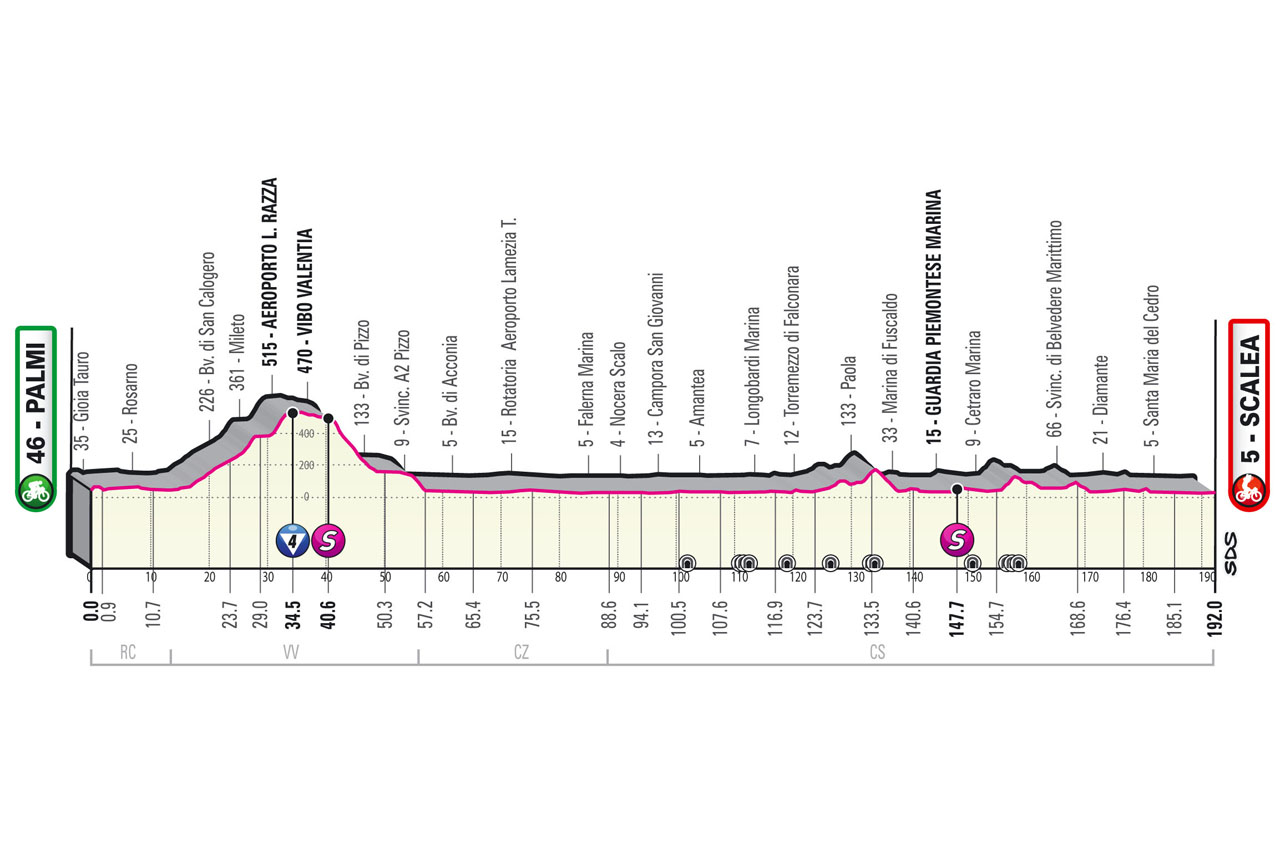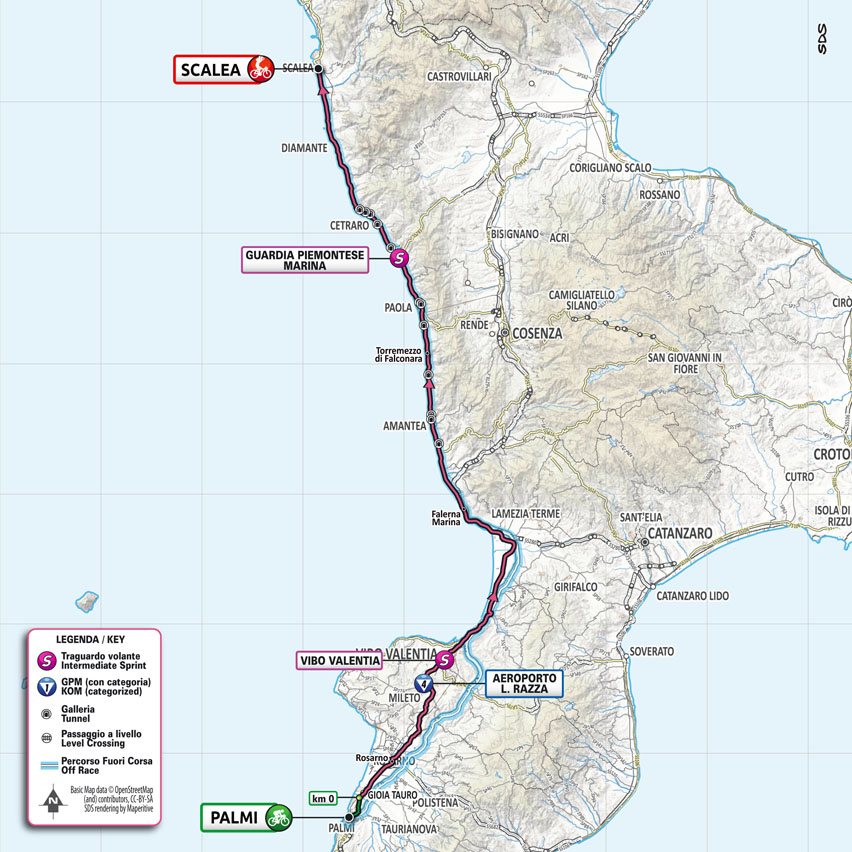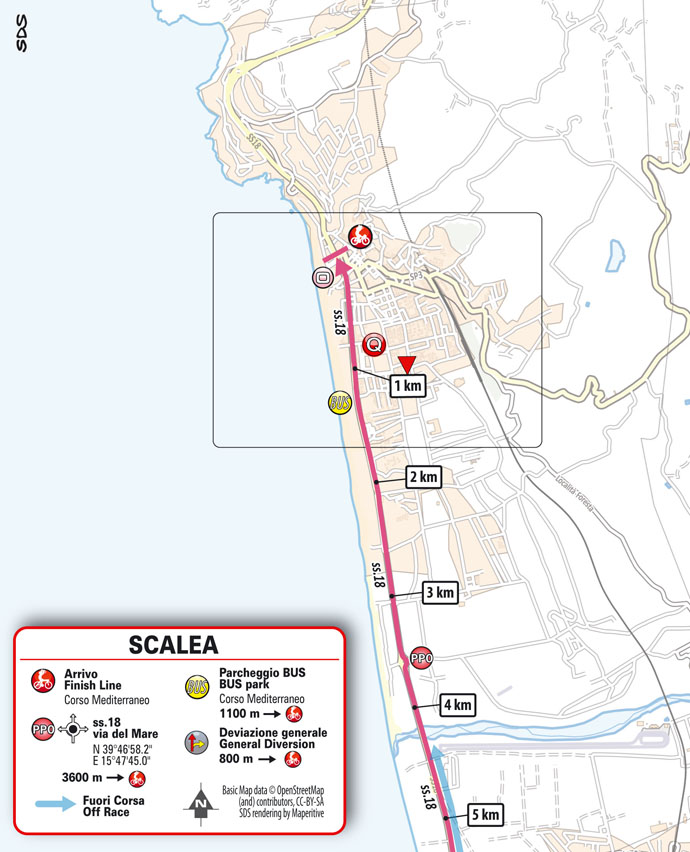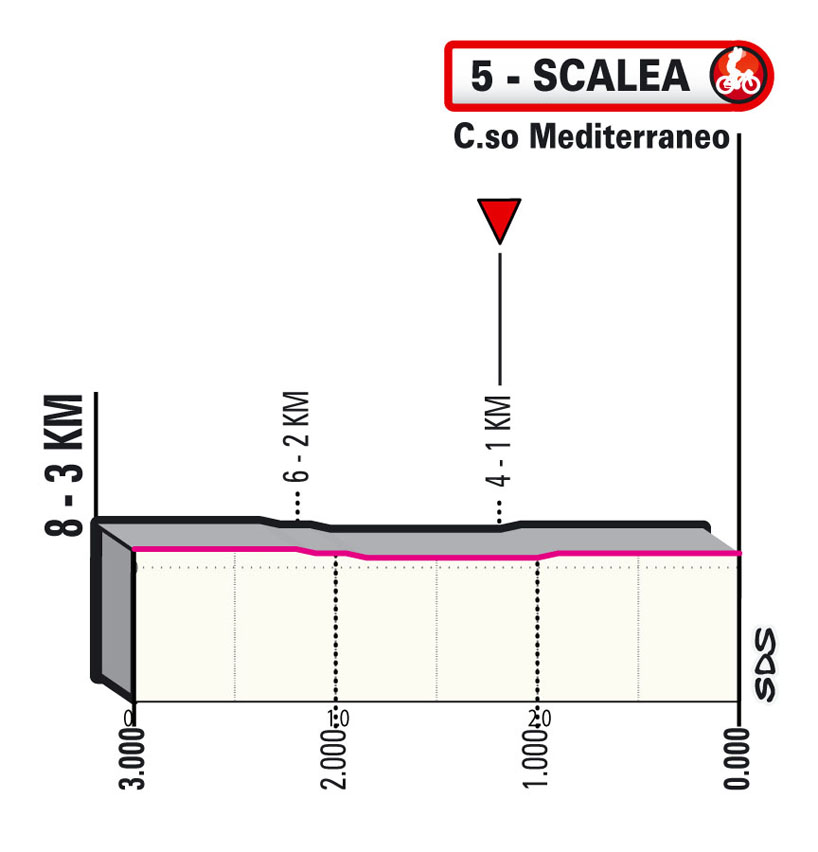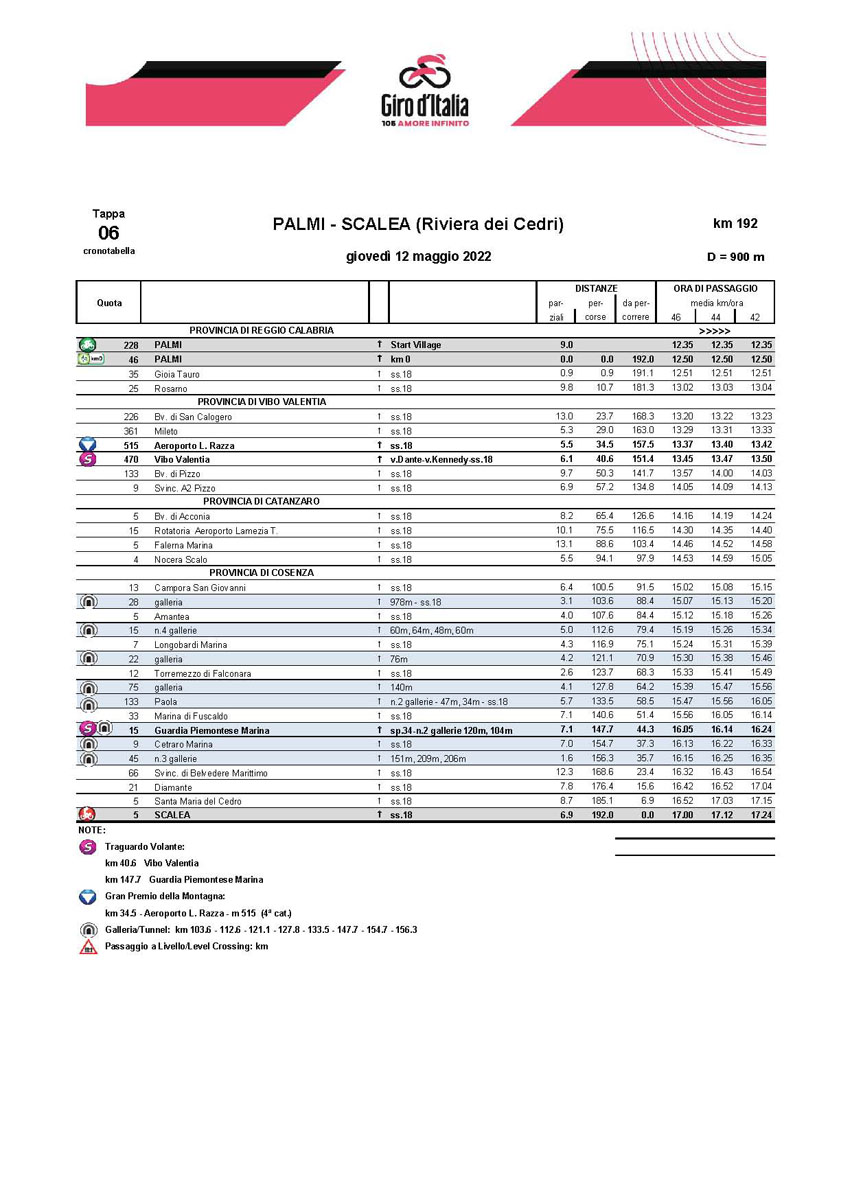profile
map
technical info
The route
The route is undemanding, and winds its way on a wide roadway along the ss. 18 trunk road, with just a few tunnels along the course. The long yet mild climb leading from Mileto to the Razza airport in Vibo Valentia is the only impediment along the route.
Final kilometres
The route enters urban Scalea for the stage finale, which is raced on wide, straight and well-paved roads, with one last roundabout at the ‑3 km mark. The home straight is on tarmac road.
start / finish
final kilometres
itinerary timetable
tourist info
Host city:
Palmi
Touristic information
The city of Palmi is set on a hill on the southern Tyrrhenian coast of Calabria . The many panoramic points allow you to enjoy the view of the Strait of Messina, the Aeolian Islands and Capo Vaticano. Protected on one side by Mount S. Elia, which is the most protruding spur towards the sea of the Aspromonte chain, founded at the end of the 14th century on a 10th century settlement of the Taurianesi, Palmi was the birthplace of many illustrious men, such as: Francesco Cilea, Leonida Repaci, Domenico Antonio Cardona and Nicola A. Manfroce. Starting from the white beaches of the Tonnara and proceeding along its 11km of coastline, we arrive at the splendid coves Marinella and Rovaglioso. The Scoglio dell’Ulivo (Rock of the Olive Tree), a unique and very rare rocky conformation, has become an icon of the city. All these coastal beauties are an integral part of the extraordinary “Costa Viola” (Violet Coast) area, characterized by crystal clear water and breathtaking seabed, a destination for diving enthusiasts. We also find cliffs overlooking the sea through which the “Tracciolino”, one of the most evocative nature trails in the Mediterranean, winds its way.
Main sights
The Crypt of San Fantino. Under the remains of a nineteenth-century little church, an underground environment welcomes a spring and preserves an early Christian treasure among the fragments of the frescoed walls. From this place the rediscovery starts, a mystery hidden for centuries resurfaces from the words of a bishop, who wrote in the eighth century about a great thaumaturge, the oldest among the Calabrian Saints: San Fantino il Cavallaro.
The Archaeological Park of the Tauriani is located on a plateau overlooking the Tyrrhenian Sea , “the sea of myths”, and on the beaches of the Tonnara. Evidence of the prehistoric period, it is characterized by a unicum, the presence of the Italic people of the “Taurians ”, whose settlement (Taurianum) dates back to the 4th century BC and was covered with the Roman city of “Tauriana” which dates back to the 1st century B.C. Numerous archaeological remains of this city have been found, including: a building for performances (amphitheater), the podium of a temple and a road axis. The coastal tower dates back to the Middle Ages and is the only one that can be visited in Southern Italy.
The “House of Culture” named after “L. Repaci ”, home to important museums and the library;
The Villa Giuseppe Mazzini, which is one the national monuments, is a botanical park characterized by a long balcony overlooking the Strait of Messina and dominating the Costa Viola, from which you can witness extraordinary sunsets on the Aeolian Islands.
Among the religious festivals there is the characteristic Procession of “San Rocco”, with the Spinati (People wearing sorts of crowns of thorns).
The Varia, thanks to which Palmi has become part of the Network of Large Shoulder Machines, recognized as an Intangible Asset by UNESCO.
The Varia di Palmi looks like a spectacular white cloud suspended in the sky, 16 meters high and weighing about 20 tons, with an imposing iron structure covered with papier-mâché erected on an oak wood base, called “u Ccippu”. The procession of this imposing votive chariot scenically evokes the Assumption of the Virgin Mary into heaven. At the top of the structure, well harnessed on a little seat, sits “the Animella” (the Young Soul). It is a little girl who plays the role of Mary assumed into heaven. A little lower than the Animella, on a pedestal, stands “u Patraternu”, the Eternal Father, who, with his outstretched arm, supports the pole to which the child is secured.
The Tonnara di Palmi beach, overlooking the Tyrrhenian Sea, owes its name to an ancient trap, built in the early 1900s for swordfish fishing. It is a splendid white sand beach bordered to the south by the imposing Scoglio dell’ulivo: a rock in the middle of the sea that can be reached by swimming, on which there is a lone olive tree. The sea that bathes this beach is nothing short of wonderful: turquoise, limpid and transparent.
The Marinella. A true pearl of the Calabrian seas, a place that captivates, a beautiful cove characterized by the absence of sand, only granite stones that make the seabed crystal clear. Highly recommended for divers.
Caletta Rovaglioso. A rocky beach as small as it is precious, it is one of the 10 most beautiful beaches in Italy according to the Travel 365 blog. A painting that is worth seeing live at least once, a wonderful melody that deserves to be listened to up to the end.
Villa Pietrosa. Leonida Repaci, one of the most famous and well-known Calabrian writers, wanted to donate this residence to the Municipality of Palmi so that it could be valued as a real treasure of art.
Scalea
Touristic Information
Scalea is one of the oldest cities in Calabria: it is the Heir of the Greek-Lucan city of Laos and the Roman Lavinium. From the wide coasts and the crystal-clear sea, you can go up through a gorgeous and picturesque street, that climb into a suggestive ancient village with typically medieval architecture.
Scalea is located on a stepped hill dominated by the ruins of the Norman Castle and is characterized by its narrow and winding alleys, the steps in living stone, and historic buildings. On the coast, there is the Ajnella cliff, full of caves and small bays, while the beach extends for kilometers to the south and it is interrupted only by the imposing reef on which it rises Talao Tower.
Scalea today is a renowned tourist center developed on the edge of the long beach that attracts thousands of tourists from all over the world every summer. The crystal clear sea and the beautiful beaches, together with the rich offer of accommodation facilities and residential complexes have contributed to making it a very popular holiday resort.
Located in the north-western part of Calabria, Scalea is situated in the heart of Riviera dei Cedri. A flap of land that extends for about thirty kilometers along the Tyrrhenian Seaside through the Pollino National Park, that represent the west gate of the largest National Park in Europe. The territory includes beautiful littoral towns such as Praia a Mare, San Nicola Arcella, Scalea, Santa Maria del Cedro, Diamante and Tortora, but also characteristic hill and mountain villages including Orsomarso, Santa Domenica Talao, Verbicaro, Buonvicino, Aieta, and Papasidero.
The label of Riviera dei Cedri stems from a typical local cultivation, that is the Cedar. During the summer time, several rabbis come to Riviera to choose the fruits to be used for the celebrations of the sukkot, that represent one of the most important religious events for Jews around the world.
The seabed of the “Riviera dei Cedri” Regional Marine Park, among which those around the Island of Dino and Capo Scalea, are enlivened by colorful flora and fauna, but it is enough to travel a few kilometers from the coast of the Tyrrhenian Sea towards the hinterland to find oneself immersed in a tipical scenario, that is Park Pollino National Park, with streams that cross wild woods forming gorgeous rapids and waterfalls.
The millenary history, characterized by prehistoric traces still visible, has given the Riviera dei Cedri treasures of art from the Paleolithic graffiti of the Grotta del Romito in Papasidero, passing through the small treasures of archaeological sites parks, Renaissance palaces, and medieval towers scattered all over the area.
Gastronomy
The gastronomic tradition of Scalea is based on modest recipes and dishes, handed down from generation to generation; however, they are often revisited in a modern way, even if they use local raw materials. It is a very simple seafaring culture that includes in the gastronomic tradition also the farmer culture; this is coherent with the landscape that is characterized by the mountains that meet the sea within a short walking distance.
The main element of the Scaleota cuisine is the blue fish: from marinated anchovies to stuffed ones, up to rosamarina. “Spaghetti alla scaleota” flavored with anchovies, tomato sauce and crispy stale bread passed in red pepper and enriched with hot pepper is a must in the menus of restaurants and trattorias. Among the first courses based on meat, it is not possible to miss the fusilli with meat sauce, made from mixed pork, veal and with the classic braciola or the more decisive goat meat sauce. Among the second courses a typical dish is the fried codfish stands out accompanied by browned peppers, dried in the summer sun and then fried for a few seconds in boiling oil to give crunchiness.
Another important place is represented by cold meats and sheep and goat cheeses above all. There are many side dishes, from the classic pickled vegetables like aubergines, courgettes and dried tomatoes, to fresh ones like “pip ‘e patan”, peppers and potatoes stewed in a pan with a truly unique taste.
Very interesting are the reinterpretations of typical first courses of Italian cuisine such as carbonara transformed into a “marinara “version and the integration in the local cuisine, the use of the Santa Domenica Talao truffle.
The desserts reflect most of all the simplicity of the local gastronomy: the fichi secchi, the crocette, the Christmas roses, the Easter pizzatole and then all the various cedar preparations expertly proposed by the pastry chefs of the area.
Beverages
On the scaleoti’s table cannot miss the wine made in Verbicaro and the one made in Buonvicino, and, as digestives, the classic cedar and the limoncello liqueurs.
Main sights
In Scalea, in addition to the sights linked to the coastline, it is worth dedicating a few hours to visit monuments and points of historical and artistic interest such as the Palazzo dei Principi, Torre Talao and the frescoed the ruins of the Basilian churches of the IX century.
Scalea’s patron, whose festivities take place every year on 16 July, is the Beata Vergine del Carmelo (Blessed Virgin of Carmel), whose statue is kept in the Chiesa Madre di Santa Maria d’Episcopio, in the heart of the old town centre. Another solemn celebration is reserved in honour of the Madonna del Lauro, patron saint of sailors, whose statue is kept in the chapel of the same name located in the town’s centre. Both processions feature the traditional “cinte votive”, special wooden frames on which candles are placed decorated with ribbons and the typical “infiorata”; floral paintings and sacred images drawn on the road’s surface with colourful sawdust.
Talao Tower
The Tower is the symbol of the city and the rock on which it stands was once a small island whose caves were inhabited in prehistoric times.
It was built in the 16th century, under the reign of Charles V, to defend the territories from raids and it was part of a sighting system along the coast to defend against attacks by Turks.
From the terrace at the top of the tower incredible views can be seen of the entire long beach that goes from the cliff of the Ajnella until the island of Cirella.
According to Homer, Talao Tower saws the passage of Aeneas and Ulysses, and right near the tower Dragon, the companion of Ulysses died.
Princes’ Palace
It was built in the XIII century, probably on a defensive tower to one of the entrance gates to the village. It was the residence of various feudal lords and housed several famous figures of the past such as the writer Giovanni Vincenzo Gravina, the poet Pietro Metastasio and the philosopher Caloprese. The precious Baroque frescoes that decorate the ceiling of the main lounge belong to that period.
Currently, the building is owned by the Municipality and one of its halls houses the Municipal Library.
The Norman Castle
The ruins of the ancient Norman Castle can be seen from the highest area of the old town centre but these cannot be visited. Built in the XI century by the Normans as a sign of power and domain on their feudal lands, it was enlarged by Roger I of Sicily toward 1060 and restored during various eras. Within its walls the Patto di Scalea (Covenant of Scalea) was signed, with which Robert Guiscard divided the Calabrian lands conquered with his brother Roger. Over the course of the centuries, the castle was permanently it was definitively abandoned by nobles who moved into the Palazzo dei Principi.
Tower of Judah
Today, only a few ruins remain of the Tower that stands at the top of the hill overlooking the old town centre, guarding the Castle. The Tower of Judah, which overlooked the entire coast, allowed easy communications with the castle and vice versa.
The origin of the name is linked to a legend relating to an episode of the many Saracen raids: due to a deception perpetrated to his detriment by a young and beautiful woman, accomplice of pirates, the guardian of the tower did not warn the Castle of the imminent Saracen landing which attacked Scalea, looting it violently. The traitor was tortured and hanged near the tower.
Antiquarium – Torre Cimalonga
Located in one of the squares of the old town centre with panoramic views, the Antiquarium is housed in the Torre Cimalonga (Cimalonga Tower), built during the period of Aragonese rule to defend one of the four entrance gates to the village. The small museum houses a permanent exhibition of archaeological finds arranged in glass display stands making use of the ancient slits through which cannons were fired, which explain the area’s historical-archaeological development, from the Palaeolithic to the late Roman period, and the populating of the area of Scalea and the ancient city of Laos. On display are pottery and the rim of the flush goblet from the end of the VII-VI century B.C.; tableware painted black; terracotta discs with the depiction of a cupid in blocks; a beautiful decorative element in the shape of the head of Silenus and casts of some of bronze coins of the mint of Laos related to the Hellenic period.
Church of Santa Maria d’Episcopio
Known as the Chiesa di sopra (Church above), its bell tower stands on the top of the old town centre. Inside, it boasts various wooden statues of southern art, such as the painting of the Annunciation attributed to the school of Solimena and the seventeenth century canvas of the Circumcision by Paolo de Matteis. On the right side there is a marble chapel which features the statue of the Beata Vergine del Carmelo (Blessed Virgin of Carmel), the town’s patron saint; while the Madonna del Carmine, dressed in the Carmelite style, with a golden crown on her head and a blanket of stars, reigns in the niche above the steps of the altar in polychrome inlay of eighteenth century Neapolitan art.
St Nicholas’ Church in Plateis
Also known as the Chiesa di sotto (Church below), it was probably built over a Byzantine chapel, extended and opened for worship during the XIV century. Behind the high altar there is an impressive oil painting from the XVII century depicting the Madonna del Carmine between St Nicola and St Charles Borromeo. A staircase to the right of the entrance leads down into the Cripta dell’Addolorata (Crypt of Our Lady of Sorrows), whose hall has a plaque that commemorates the burial of Scalea’s philosopher, Gregorio Caloprese.
Typical of Byzantine architecture is the cross vault with three naves divided by eight low columns, with the walls embellished by frescoes. An altarpiece depicting St Anthony of Padua, perhaps of the Flemish school, can also be found here as well as various frescoes of the 1700s.
The shrine of the Madonna del Lauro
The shrine was built in the XVIII century by local seamen and the inhabitants of Sorrento, to dissolve a vow made to the Madonna during a storm in which the crew from Campania promised to build a church in the point where the sea had washed them ashore safely.
Today the Virgin is celebrated with an impressive procession at sea and the local sailors symbolically re-live the arrival of the statue of the Madonna by sea. In its interior, the shrine boasts a statue in plaster, which depicts the Madonna with the child in her arms, to which was added a crown in silver, in sign of devotion.
Ajnella cliff
The cliff is a succession of majestic rocky walls, sharp rocks of an anthracite colour, solitary beaches and natural sea caves.
Rocks that deserve a mention are those that the old fishermen called Carusiello, that reminds us of a child’s little pottery piggy bank, and Lastrachiello , that due to its flattened shape resembled the floor of the entrance to a house. Close to the shore during low tide, a rock emerges from the water known as Scoglio della Giumenta (Rock of the Giumenta), whose profile reminds us of the back of a horse
.
The Grotta du Trasi e jesci (Enter and leave) is a natural tunnel that comes out on a beach in the shape of a thimble, called “A Jiditala”. The Grotta della Pecora owes its name to the great stalactite in the form of a sheep’s head that dominates the entrance and inside the crystal-clear water fades in colours that constantly alternate.































